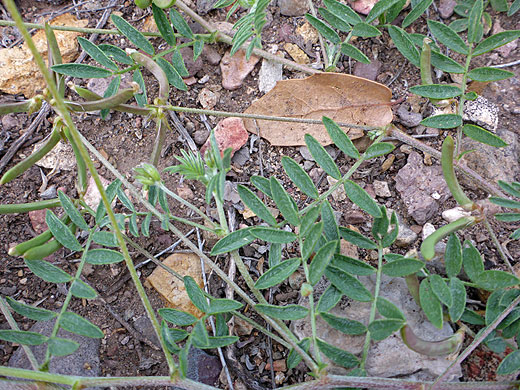
Purple and bluish petals of astragalus emoryanus, along the Ward Spring Trail in Big Bend National Park, Texas
Common name:
Emory's milkvetch
Family:
Scientific name:
Astragalus emoryanus
Main flower color:
Range:
Far south Utah, and scattered areas of Arizona, New Mexico and south Texas
Height:
A few inches; usually prostrate
Habitat:
Open hillsides and flats
Leaves:
Divided into 11 to 19 elliptic or ovate leaflets; up to 3 inches long overall
Season:
March to May
Stems of astragalus emoryanus are generally prostrate, between 1 and 2 feet in length. They, and the leaves and calyces, have a relatively sparse covering of strigose hairs. Leaves are divided into an odd number of non-overlapping leaflets (between 11 and 19), each less than half an inch long. Leaflet tips may be pointed or rounded, and not usually notched. Small stipules grow at the leaf attachment points.
Flowers are formed singly or in small clusters; they are a little less than half an inch long, mostly pinkish purple in color though the center of the banner petal, the base of the wing petals and the upper part of the keel petals are white. Petals become bluish as they wither. Fruits are hairy, green or reddish pods, up to 1.5 inches long, and uniformly curved, often by 90 degrees or more. There are two varieties (var emoryanus and var terlinguensis), the latter found only in far west Texas, in and around Big Bend National Park.
Flowers are formed singly or in small clusters; they are a little less than half an inch long, mostly pinkish purple in color though the center of the banner petal, the base of the wing petals and the upper part of the keel petals are white. Petals become bluish as they wither. Fruits are hairy, green or reddish pods, up to 1.5 inches long, and uniformly curved, often by 90 degrees or more. There are two varieties (var emoryanus and var terlinguensis), the latter found only in far west Texas, in and around Big Bend National Park.
All Contents © Copyright The American Southwest | Comments and Questions | Contribute | Site Map





